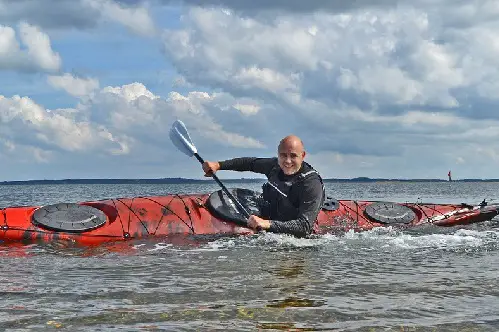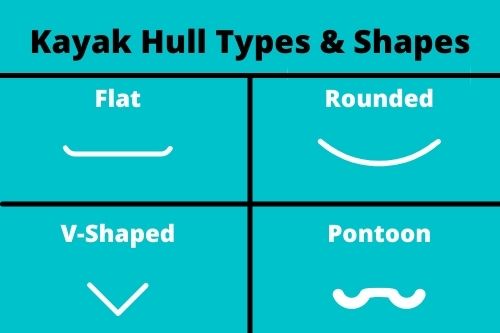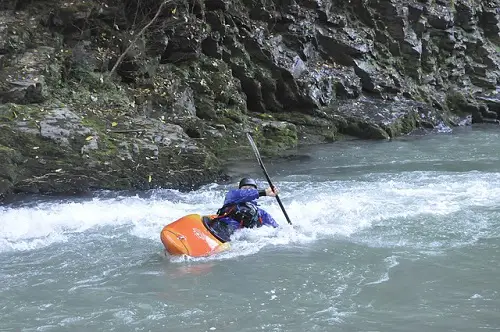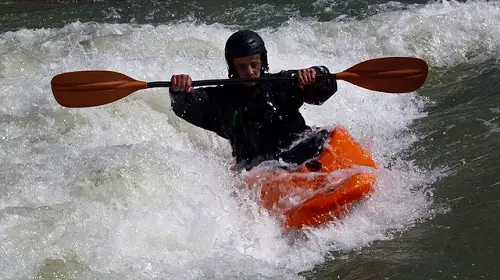If you’re new to the world of paddling sports, there are many things you should know about kayak stability. A few years ago, I was also wondering how safe kayaking is. The first worry every beginner will have is to lose his balance and flip over.
So it’s normal to ask yourself: Are Kayaks Stable? But it’s a tricky question because each model is different. Although there’s not one fit-to-all answer, here’s what you should know concerning stability.
Kayaks are generally stable and do not flip over easily. But some models are more likely to capsize than others. The stability of a kayak will mainly vary according to its dimensions and hull design. Recreational, fishing and inflatable kayaks are generally more stable in calm water than river and ocean kayaks.

In whitewater or waves, it’s a whole new reality. And lack of stability will also come with other advantages such as better speed or maneuverability. So it’s essential to analyze the boat design before heading out in the water.
With my experience, I can now understand whether a kayak is stable or not just by looking at it. In this article, I would like to help you do the same. Optimizing your stability in the water will make your paddling adventures much more fun and safe.
How Stable Is A Kayak?
Even though most kayaks are stable, it’s specific to each one of them. Their design can influence how easy or hard they are to flip over. You should consider a few things to determine the stability of a boat.
Is Kayaking Really Safe?
Many people wonder how stable kayaks are because they don’t know if paddling in one is dangerous or not. Well, capsizing is a risk of the sport. It will happen to every kayaker someday, and there’s no way to avoid it.
However, you can reduce the likelihood of tipping over to a certain extent. For example, choosing a kayak that offers more stability might not be a bad idea. If you don’t want to capsize, there are precautions you can take to prevent it.
Types Of Kayak Stability.
Before going any further, you should understand the terms in the main question. You probably know what kayaks are and what stable means. But in this context, you can look at stability from two different angles.
Primary Stability. (When The Kayak Is Vertical)
The first type is all about how stable the kayak is in calm water. It means the boat will remain flat and you won’t be able to lean a lot from one side to another. Initial stability can be convenient for beginners to increase their confidence and keep their boat level off.
With a kayak that offers this type of stability, you’re not likely to capsize if your upper body stays relatively straight and you paddle the right way. On the other hand, you will quickly notice the problem when you suddenly move or lean too much.
The primary stability won’t keep the kayak from flipping over past a specific point. It’s also much harder to stop it with bracing or recover from it by rolling. Nonetheless, it’s not a big deal for beginners that paddle in calm water. (Lakes & Slow Rivers)
Secondary Stability. (When The Kayak Lean)
The other type can help you keep your balance, even when the boat isn’t flat on the water. Secondary stability allows you to lean on one side to another quickly and easily without capsizing. That’s why it’s more appropriate for whitewater and ocean kayaking.
On the other hand, boats with this type of stability don’t feel safe in calm water. They lean more when you paddle and are more responsive to your hips’ movements. So it can seem easy to flip over in such conditions for beginners.
But secondary stability is essential if you kayak in technical rapids, high waves, or windy conditions. It allows you to have more control and avoid capsizing because of sudden movements. Therefore, it’s ideal for advanced paddlers.
What Type Of Stability Do You Need?
Unfortunately, no kayak has both optimal primary and secondary stability. Thus, you must choose what’s the best option for you. In general, it will depend on where you plan to paddle, the water conditions, and your kayaking experience.
For recreational use and fishing, your boat needs to be stable in a calm environment. On the flip side, the second type of stability is more appropriate for kayaking in whitewater, strong currents, waves, etc.
It’s also essential to consider your paddling skills. The primary stability is more appropriate for beginners to feel safe in a kayak. But if you have a lot of experience, the second type of stability might be more convenient to increase your maneuverability.
Overall, both are valuable in certain situations. For the rest of my article, I will use the term stable or kayak stability in a general sense, which means its ability to avoid capsizing.
What Makes A Kayak Stable?
Since every boat is unique, the stability will change from one model to another. Regrouping all kayaks in a single basket is an error. They all have different features, so their capacity to not tip over is not the same.
You must analyze some elements to figure out how stable a kayak is. The boat construction will give you an excellent idea of the experience it offers in the water. So here are the main elements that can have an impact on your kayak stability.
Look At The Hull Design.
The hull is the main body of a boat. On kayaks, it’s the bottom part that makes floating possible. Since it’s the only point of contact with the water, you can understand how the hull shape will influence the overall stability.
There are four main types of kayak hull: Round, V-Shape, Flat, and Pontoon. Some of them are more stable than others. Here’s more information about each hull design.

Pontoon Hull. (Most Stable)
Some recreational kayaks have a similar hull shape to pontoon boats for optimal stability in flat water. Both sides of the bottom piece are longer, and the center is rounded toward the interior to form a tunnel.
A kayak with a pontoon hull is extremely stable. That’s why most fishing or recreational models have this feature. It offers excellent primary stability, but the maneuverability and speed aren’t good.
Flat Hull. (Offer Good Primary Stability)
Kayaks with a regular flat bottom are stable in calm water as long as you don’t make sudden movements or lean too much. If you roll past the hull sides, your probability of capsizing is high. Therefore, it doesn’t offer good secondary stability.
Although it’s a simple design, flat hulls are popular in a variety of kayak types. They are stable and provide excellent maneuverability. So you can find them on recreational, fishing, and some playboats. (whitewater)
Rounded Hull. (Provide Great Secondary Stability)
A round bottom doesn’t feel very stable, but it can be in specific conditions. Kayaks with this hull shape are easy to maneuver and keep you upright even when they lean from one side to another.
The excellent secondary stability and increased control make this design ideal for whitewater and river kayaking. Intermediate and expert paddlers will also often prefer rounded hulls.
However, they aren’t always the right option for beginners. A kayak with a rounded bottom makes it hard to keep a straight line. So it’s not the best construction to learn or go fast in calm water.
V-Shaped Hull. (Lack Of Stability)
Kayaks with a triangular (V) bottom piece don’t provide much stability and maneuverability. They are more appropriate for speed, long-distance paddling, and optimal tracking through the water.
Touring, ocean, and racing kayaks generally have a V-shaped hull. It’s perfect to go fast and break waves, but it’s not the most stable design. That’s why you’re more likely to capsize with this type of hull.
Consider The Kayak Dimensions.
Another factor that can influence the stability of a boat is its length and width. In general, wider kayaks are more stable. On the other hand, narrower models are often faster. Then, the kayak length doesn’t influence how easy it is to flip over.
Width is the most important dimension to consider for kayaking stability. It’s one of the main factors that make some boats less prone to capsizing. So here’s the standard width range for each kayak category.
| Type Of Kayak | Width | Level Of Stability |
| Recreational Kayaks | From 27 to 36 inches. | 4/5 |
| Fishing Kayaks | Up to 42 inches. | 5/5 |
| Sea & Touring Kayaks | From 18 to 24 inches. | 2/5 |
| River Kayaks | From 23 to 28 inches. | 3/5 |
The width changes a lot from one model to another. But the numbers above can still give you an overall idea of the stability depending on the kayak type.
Most of the information above comes from this article on the WhaleNation blog. Then, I also use real-life data by looking at the boats available on the market.
The volume of a kayak is also essential to consider because it will determine how much weight it can safely carry. Exceeding the capacity will have an impact on stability. Paddling in a kayak that’s not appropriate to support you makes it more likely to capsize.
Don’t Forget The Kayak Purpose.
Each boat has a unique construction for a reason. Fishing kayaks are stable because it’s necessary to cast and fish safely. On the other hand, ocean and touring models have a design providing optimal speed over long distances.
That’s why the stability level is not the same from one kayak to another. Some do well in calm water, and others perform better in whitewater. If you know what intent is behind the boat, you’re more likely to understand how stable it is and where you can use it safely.
How To Know If A Kayak Is Stable? | Give It A Try!
The ultimate solution to answer your question is by testing the stability of the kayak in question. You won’t understand how easy it is to capsize before you try it. Therefore, I highly recommend finding a calm and safe place to flip your boat over intentionally.
It will allow you to figure out what you can or can’t do while paddling. As I already told you, every kayak is different. Looking at it can give you an idea of how stable it is, but trying it is the only way to make sure your assumption is exact.
So prepare your equipment and go on the water. You can test your kayak tipping point and flip over as many times as you want. This fun activity will help you analyze its stability and overcome the capsizing fear every beginner has.
FAQ | Kayak Stability
You probably have many other specific questions related to how stable a kayak is. It’s normal to want more information about the risk of tipping over. Well, here are some answers to help you prepare mentally for kayaking.
Are Recreational Kayaks Stable? (Yes)
Recreational kayaks are highly stable in flat and calm water because they are wide and relatively short. Their design is well-suited for beginners, so they don’t flip over easily. Although the hull shape can highly vary from one model to another, recreational boats generally offer excellent primary stability.
Are Fishing Kayaks Stable? (Absolutely)
Fishing kayaks generally provide a lot of stability. Otherwise, users wouldn’t be able to carry all the necessary gear and cast safely. The design of a fishing kayak is the widest, which makes them feel very stable. However, you shouldn’t use one in whitewater because of the poor maneuverability and lack of secondary stability.
Are Sea & Touring Kayaks Stable? (Not Really)
Designed for speed, touring as well as sea kayaks are long and narrow. They also often have a v-shaped hull for better tracking in the water and breaking through waves in the ocean. So it’s not the ideal construction for stability.
Are Whitewater Kayaks Stable? (It Depends)
Whitewater kayaks will offer excellent secondary stability, but they are relatively easy to flip over in flat water. They are well-suited to go down rapids, not to keep you stable while you paddle a calm lake. River kayaks also lack primary stability but provide optimal maneuverability and allow you to roll easily.
Are Inflatable Kayaks Stable? (Yes)
Inflatable kayaks are significantly more stable than hardshell models. Their construction has air to float, is generally wide, and the hull is often less angled. So it can be hard to capsize in this type of kayak, even intentionally. On the other hand, it doesn’t provide secondary stability.
Are Sit-On-Top Kayaks More Stable Than Sit-in?
Sit-on-top kayaks might seem more stable than sit-inside models, but they offer different types of stability. A sit-on kayak is safer to use in calm water because it provides exceptional primary stability. The sit-in kayak design is more appropriate for whitewater or waves due to its better secondary stability.
Both options also have other unique advantages. Sit-on-top kayaks are generally wider and have a flat or pontoon hull, which might feel more stable. However, a sit-inside kayak has a lower center of gravity, which can help you keep your balance.
Are Kayaks More Stable Than Canoes?
Right from the start, I’ve compared kayaks to kayaks for a fair comparison. But putting them side to side with another type of watercraft might help us understand their comparative stability. Unfortunately, the kayak is more likely to flip over than most other boats.
Canoes might seem more stable than kayaks because of their width, but it’s not as simple. It’s also essential to consider how difficult it can be to keep your balance with a higher gravity center. Despite that, the higher volume and hull design make canoes more stable than kayaks.
In my opinion, a beginner is more likely to capsize in a canoe because they are tricky to maneuver. So it’s not rare to make a mistake, lose your balance, and fall out in the water. When it comes to kayaking, inexperienced people usually have less difficulty remaining stable while paddling.
The environment is also essential to consider. In calm water, I would preferably use a canoe due to its excellent primary stability. Nonetheless, the kayak generally has better secondary stability because the center of gravity is lower. So this type of boat is more appropriate to paddle in whitewater and waves.

How To Make A Kayak More Stable? (To Avoid Capsizing)
Although kayaks are stable, the risk of flipping over is always there. If you get into this water sport, you will inevitably capsize someday. But don’t worry, I’ve found a few ways to increase your stability and help you keep your balance while paddling.
Choose The Right Boat.
The first step of the process is to use a stable kayak. As I’ve shared with you, every model is different. So you should choose one that provides a lot of stability.
In general, sit-on-top recreational and fishing kayaks with a pontoon hull are the most stable to paddle in calm water. If you plan to go down rapids, you should opt for a whitewater boat such as a river runner (good primary and secondary stability) or a creeker (optimal secondary stability).
On the ocean, you might have to break through waves and paddle in strong rip/tidal currents. That’s why sea kayaks go fast and have optimal tracking in the water but aren’t very stable.
However, you can pick a wider one to reduce the risk of capsizing. Touring kayaks also tend to be more stable and are suitable for open water such as lakes, bays, and calm parts of the ocean.
Most Stable Kayaks.
To help you find the perfect boat for your needs, I’ve done some research. Since stability is our main concern for today, here are the most stable kayaks on the market.
- Most Stable Recreational Kayak: Pelican Sit-On-Top Sentinel 100X
- Most Stable Fishing Kayak: Pelican Sit-On-Top Basscreek 100xp Angler
- Most Stable Whitewater Kayak: Dagger Nomad 9.0
- Most Stable Touring/Sea Kayak: Perception Expression 11.5
- Most Stable Inflatable Kayak: AdvancedFrame
Consider The Water Conditions.
Once you have a stable kayak suitable for your needs, it’s time to plan where you will paddle. The boat itself isn’t the only factor that influences how easily you can flip over. You also have to consider the water conditions.
First, you need to use your kayak in the right environment and in the proper way. There are different models for good reasons. So don’t go in rapids with a sea kayak, it’s not appropriate for this purpose.
Then, it’s also essential to choose the best time for your paddling adventures. Heading out in the water during strong winds or a thunderstorm isn’t fun nor safe. Kayaking when the weather is nice can make it as enjoyable as possible.
Ensure Your Kayak Is Well Balanced.
Another way to prevent you from tipping over while paddling is to stabilize your boat. Make sure the seat is well-adjusted and that you are in the center of the kayak. Otherwise, it can be hard to keep your balance when your position isn’t stable.
If you have to carry gear, it’s essential to place all your stuff evenly. Make sure the weight is spread equally on both sides, in the back, and front. Without initial stability, your kayak is more likely to capsize.
Invest In A Stabilizer System.
Believe me; you’re not the first person to wonder how a kayak can be made more stable. Fortunately, some people have already invented solutions to our problem.
Whether you want to improve your boat stability or decrease the risk of capsizing, investing in a stabilizer system is worth considering. The Scotty 302 is two inflatable pontoons that you can fix on each side of a kayak.
It’s an ingenious product that offers over 30 pounds of extra buoyancy. This stabilizer system can make you more stable while paddling and keep you from tipping over. So you should check it out!
Work On Your Paddling Skills.
The problem might not be the kayak, conditions, or equipment you don’t have. It can also be your lack of experience that makes you unstable on the water. Fortunately, there are techniques you can learn to stop you from capsizing when you lose balance.
When your kayak starts flipping over, a single paddle stroke can be enough to recover. It’s called the low and high brace. Those techniques consist of smacking the water with your paddle for momentary support.
Once you master the art of bracing, lack of stability won’t be an issue anymore. You will have the skills necessary to avoid capsize when it’s possible. Apart from that, it’s also essential to work on recovery techniques because your kayak will eventually tip over.
Last Thoughts About Kayak Stability!
Overall, kayaks are stable when used in the right type of water. Their width, hull shape, and purpose will influence how easy they are to flip over. It’s also essential to understand and differentiate the two types of kayak stability.
- Primary Stability: Keep The Boat Stable & Flat In Calm Water.
- Secondary Stability: Allow You To Stay Upright In Whitewater & Waves.

I hope my article has helped you have a better idea of how stable kayaks are. With all the information in this article, I’m sure you’re ready for your first paddling adventure. Now it’s time to stop worrying about kayak stability and start having fun in the water.
Happy Kayaking!
